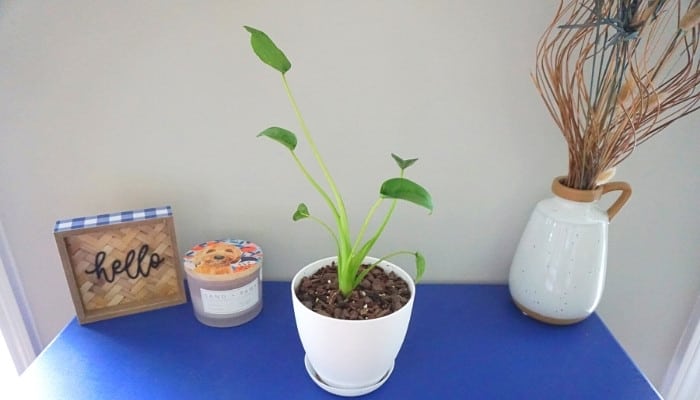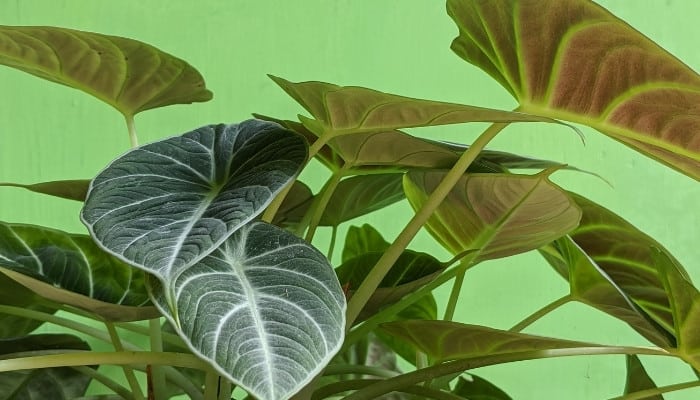Alocasia, also known as elephant ears, are highly prized plants for their large, eye-catching leaves.
The plant is native to tropical rainforests in East Asia, but people around the world cultivate a wide variety of alocasia species, including hybrids.
If you’ve thought of growing some yourself, you may have wondered:
Do alocasia have seeds? Alocasia does produce seeds. They are found within the plant’s pods, which you must crack open. The hard, seed-containing pods appear when the plant blooms, and you’ll see them hanging down from the ornate leaves. The seeds, however, take a long time to mature.
In the following, you’ll learn about how and when to retrieve the seeds as well as how to plant and care for your alocasia. Read on to learn all of this and more.
Alocasia Seeds – Harvesting and Germinating
Though seeing hanging seed pods on an alocasia is somewhat rare, you can easily take advantage of the seeds that result.
With the proper conditions and care, harvesting and germinating alocasia seeds is simple.
How Alocasia Reproduces
Alocasia sprout from roots underground called rhizomes. Splitting these rhizomes and then planting them is a common way for the alocasia to reproduce, and many consider it the best way.
However, if you’re fortunate enough to find the hanging seed pods (it’s not common), planting the seeds is a good option too.
(Just so you know, alocasia is capable of self-pollination, but it may need a little help from you once the flowers open.)
The plant remains dormant between two and three months when temperatures reach below 50 degrees Fahrenheit. Thus, if you’re seeking to propagate the plant, you should wait to do so until spring or summer.
What Do Alocasia Seeds Look Like?
Alocasia seeds look enticingly like bright orange berries – however, they’re highly toxic and shouldn’t be consumed.
You’ll find these inside big red or green pods, which will burst open and turn white (or brown) when they’re ready.
How To Harvest Alocasia Seeds
Alocasia will rarely produce flowers and seed pods. However, when you see them, you can retrieve them after ensuring the pod has dried up and changed color.
Another indicator of seed maturity is if the flowers on the alocasia have faded.
Use a pair of sharp scissors to split open the pods when you’re ready to collect the seeds for harvesting. You can then spread them out on some paper to clean them off.
Additionally, some people soak their seeds overnight, but this isn’t a necessary step.
Keep in mind that plastic materials can ruin your seeds, so when storing them, opt for paper bags.
If you’ve got different kinds of alocasia seeds to harvest, label your paper bags before placing the seeds inside.
Lastly, ensure you have the right conditions and temperature where you store your seeds. You want to choose somewhere dark with no humidity and ideally a temperature of 40℉.
How To Plant and Germinate Alocasia Seeds
Sow your seeds on the soil’s surface and cover them lightly with soil. Lightly spray on top of the area – you want it damp, not soaking wet.
You may have to wait up to 90 days for your seedlings to appear as the plant is somewhat unpredictable when it comes to germination.
Make sure the place you choose to sow your seeds receives plenty of indirect sunlight. Choose somewhere bright, but avoid sunlight hitting your plant directly as it may cause damage to the new leaves.
Water every week and lightly mist/spray frequently. Avoid watering too much during the dormant months, however. The alocasia is prone to fungal infections when the soil is waterlogged, so don’t overdo it.
How Long Do Alocasia Seeds Take To Grow?
If you’re diligent with your watering, alocasia seeds will take between three and eight weeks to grow. If you want to see the infamous colossal elephant ear leaves, however, you may have to wait years.
Though sprouting a new plant only takes a few weeks, growing the colossal leaves may take a lot longer.
Remember that alocasia plants are dormant during the winter, which means you won’t see any growth then.

The Easiest Method For Propagating Alocasia
The best and easiest method to propagate alocasia is via division. Because the plant grows from underground stems, planting these rather than the seeds is much simpler.
Follow these easy steps:
- Remove your plant from its pot. Gently shake off extra soil, and if necessary, use a little water to free the roots.
- You’ll see that there are numerous clumps on the roots, as well as pups (new baby offsets). Take a clean knife and carefully separate the clumps. Don’t worry, each of them have their own roots.
- Choose a pot that has a drainage hole on the bottom and place the clump inside. Remember, this is a tropical plant, so you want to retain just enough moisture.
- Mix potting soil, perlite, and a tad of coco-coir.
- Cover the clumps/offsets, and water them just enough to dampen the soil. Make sure they have indirect sunlight.
That’s it! Give it a few weeks to see the initial leaf growth.
Related Questions:
The most commonly asked questions people ask about propagating alocasia are regarding the removal of baby offsets (pups) and whether the seeds are edible.
How Do You Remove Alocasia Pups?
The process for removing the pups from your mother alocasia plant is the same as for removing the clumps or offsets.
It doesn’t take much: a knife or scissors and some gentle hands. First remove the mother plant from its pot, carefully cut off the pups and repot them, water them lightly, and place them in a bright, well-lit place.
Are Alocasia Seeds Edible?
Alocasia seeds are not edible. In some parts of the world, particularly in Asia, it’s common to use alocasia for medicinal purposes. The plants are placed on the skin, for example, to reduce fevers.
It’s also important not to confuse alocasia with colocasia. The latter has some edible plant parts, but you shouldn’t eat alocasia.
Summary
Alocasia is a gorgeous tropical plant, and its popularity has soared in recent years. Due to its size and aesthetic, hybrids of the plant are also popular globally.
Caring for them isn’t too challenging- all it takes is patience and providing the right care.

